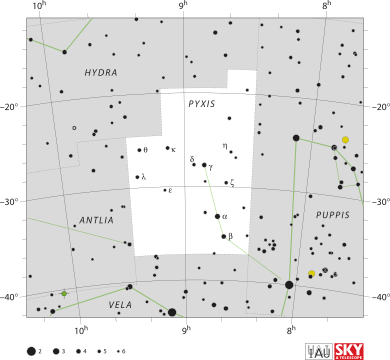Pyxis facts for kids
| Constellation | |

List of stars in Pyxis
|
|
| Abbreviation | Pyx |
|---|---|
| Genitive | Pyxidis |
| Pronunciation | genitive |
| Symbolism | the compass box |
| Right ascension | 9 |
| Declination | −30 |
| Quadrant | SQ2 |
| Area | 221 sq. deg. (65th) |
| Main stars | 3 |
| Bayer/Flamsteed stars |
10 |
| Stars with planets | 4 |
| Stars brighter than 3.00m | 0 |
| Stars within 10.00 pc (32.62 ly) | 1 |
| Brightest star | α Pyx (3.68m) |
| Messier objects | None |
| Meteor showers | None |
| Bordering constellations |
Hydra Puppis Vela Antlia |
| Visible at latitudes between +50° and −90°. Best visible at 21:00 (9 p.m.) during the month of March. |
|
Pyxis is a small and dim group of stars, also known as a constellation, found in the southern part of the night sky. Its full name is Pyxis Nautica. This is Latin for a 'mariner's compass', like the one sailors use to find their way.
A French astronomer named Nicolas-Louis de Lacaille first named Pyxis in the 1700s. It is now one of the 88 modern constellations that astronomers recognize today. The flat part of our home galaxy, the Milky Way, passes right through Pyxis.
Contents
Pyxis: The Mariner's Compass Constellation
Pyxis is a faint constellation, meaning its stars are not very bright. Its three brightest stars are Alpha, Beta, and Gamma Pyxidis. These three stars form a rough line in the sky.
The Brightest Star in Pyxis
The brightest star in Pyxis is called Alpha Pyxidis. It shines with a brightness of 3.68 on the magnitude scale. This star is a blue-white star. It is about 880 light-years away from Earth. Alpha Pyxidis is also incredibly bright, shining about 22,000 times more brightly than our Sun.
Pyxis is located near the stars that once made up a much larger, older constellation. This old constellation was called Argo Navis. It represented the ship used by Jason and the Argonauts in ancient Greek myths.
Over time, Argo Navis was divided into three separate constellations. These are Carina (which means the keel or hull of a ship), Puppis (the stern or back of the ship), and Vela (the sails). These three constellations are now recognized on their own.
In the 1800s, an astronomer named John Herschel thought about renaming Pyxis. He suggested calling it Malus, which means 'the mast' of a ship. However, this idea was not used, and the constellation kept its original name, Pyxis.
Interesting Objects in Pyxis
Pyxis is home to some fascinating objects in space. One of these is T Pyxidis. This star is a special type called a recurrent nova. This means it flares up and becomes much brighter every few decades. It can get as bright as magnitude 7, which is bright enough to be seen with binoculars. T Pyxidis is located about 4 degrees northeast of Alpha Pyxidis.
Astronomers have also found exoplanets in Pyxis. These are planets that orbit stars other than our Sun. So far, three different star systems in Pyxis have confirmed exoplanets.
Another interesting object is the Pyxis globular cluster. A globular cluster is a huge, round group of thousands of stars. This cluster is about 130,000 light-years away from us. It is found in the galactic halo, which is the outer part of our galaxy. Scientists once thought that this part of the galaxy did not have globular clusters. It is possible that this cluster might have escaped from the Large Magellanic Cloud, a smaller galaxy near the Milky Way.
Images for kids
-
Pyxis can be seen overlying the mast of Argo Navis
-
Hubble Space Telescope picture of T Pyxidis, showing ejected material from past eruptions
See also
 In Spanish: Brújula (constelación) para niños
In Spanish: Brújula (constelación) para niños




